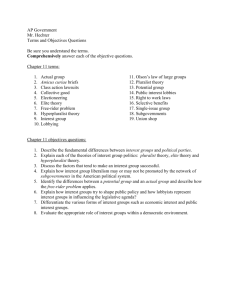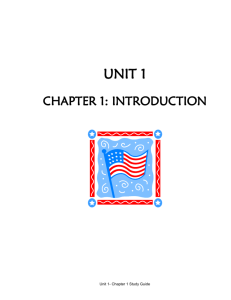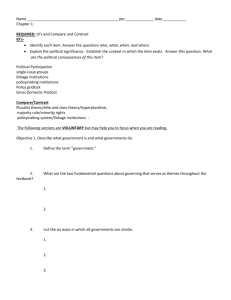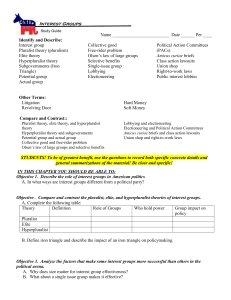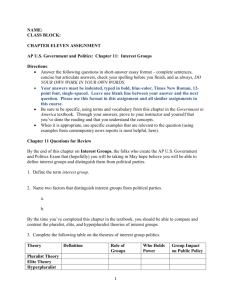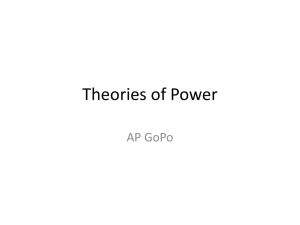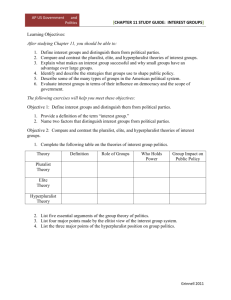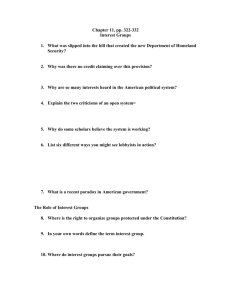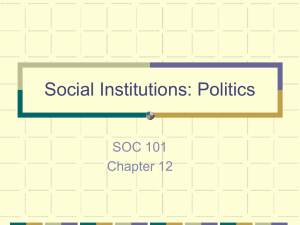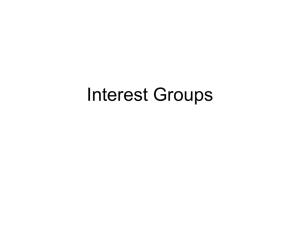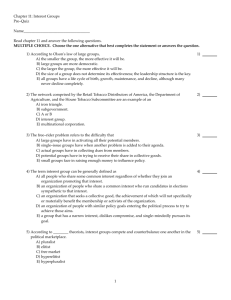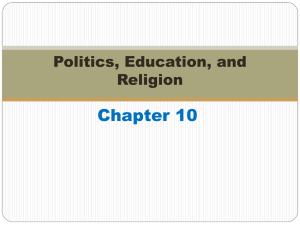Chapter 11 Practice Questions
advertisement
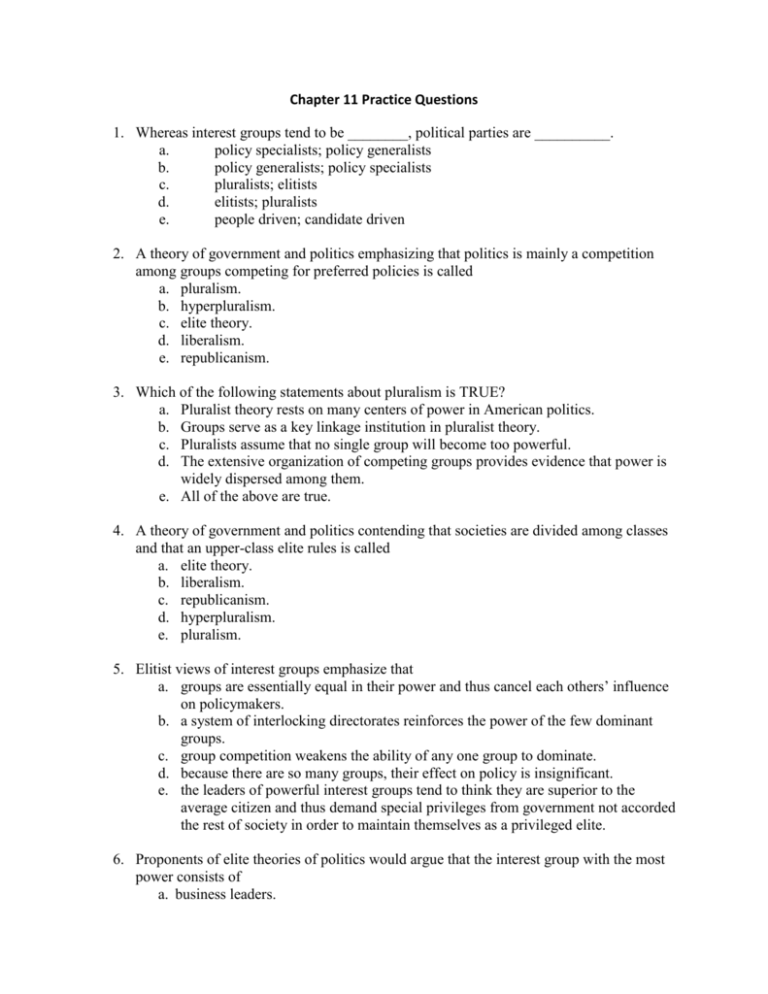
Chapter 11 Practice Questions 1. Whereas interest groups tend to be ________, political parties are __________. a. policy specialists; policy generalists b. policy generalists; policy specialists c. pluralists; elitists d. elitists; pluralists e. people driven; candidate driven 2. A theory of government and politics emphasizing that politics is mainly a competition among groups competing for preferred policies is called a. pluralism. b. hyperpluralism. c. elite theory. d. liberalism. e. republicanism. 3. Which of the following statements about pluralism is TRUE? a. Pluralist theory rests on many centers of power in American politics. b. Groups serve as a key linkage institution in pluralist theory. c. Pluralists assume that no single group will become too powerful. d. The extensive organization of competing groups provides evidence that power is widely dispersed among them. e. All of the above are true. 4. A theory of government and politics contending that societies are divided among classes and that an upper-class elite rules is called a. elite theory. b. liberalism. c. republicanism. d. hyperpluralism. e. pluralism. 5. Elitist views of interest groups emphasize that a. groups are essentially equal in their power and thus cancel each others’ influence on policymakers. b. a system of interlocking directorates reinforces the power of the few dominant groups. c. group competition weakens the ability of any one group to dominate. d. because there are so many groups, their effect on policy is insignificant. e. the leaders of powerful interest groups tend to think they are superior to the average citizen and thus demand special privileges from government not accorded the rest of society in order to maintain themselves as a privileged elite. 6. Proponents of elite theories of politics would argue that the interest group with the most power consists of a. business leaders. b. c. d. e. agriculture and agribusiness. energy and environmental groups. consumer and public interest lobbies. labor unions. 7. Another term for a subgovernment is a(n) a. iron triangle. b. interest group. c. multinational corporation. d. faction. e. political party. 8. All subgovernments have the same goal of a. protecting the public interest. b. attacking the government head-on. c. protecting their self-interest. d. electing the most qualified people to office. e. joining the main government. 9. According to Olson’s law of large groups, a. the larger the group, the more effective it will be. b. the smaller the group, the more effective it will be. c. the size of a group does not determine its effectiveness; the leadership structure is the key. d. all groups have a life cycle of birth, growth, maintenance, and decline, although many never decline completely. e. large groups are more democratic. 10. The problem faced by groups when people do not join because they can benefit from the group’s activity even without joining is called the ________ problem. a. free-rider b. single-interest c. pluralist d. hyperpluralist e. perennial 11. Goods such as publications, discounts, and group insurance rates are examples of a. selective benefits. b. free riders. c. collective goods. d. subgovernments. e. membership requirements. 12. A “communication by someone other than a citizen acting on his or her own behalf, directed to a governmental decision maker with the hope of influencing his or her decision” is a definition of a. b. c. d. e. campaigning. lobbying. electioneering. litigation. a policy output. 13. Many interest groups involve themselves in ________ to help get those they consider to be the right people into office or to keep them there. a. lobbying b. electioneering c. litigation d. policymaking e. recruitment 14. Amicus curiae briefs a. are written explanations of a court decision. b. are lawsuits submitted by interest groups. c. consist of written arguments submitted to the courts in support of one side of a case. d. enable groups of similarly situated plaintiffs to combine similar grievances into a single suit. e. are legal arguments submitted by the president’s attorneys advocating the United States government’s position in an important federal court case. 15. Class action lawsuits a. consist of written arguments submitted to the courts in support of one side of a case. b. consist of lawsuits brought to the courts by one particular social class in society. c. enable a group of similarly situated plaintiffs to combine similar grievances into a single suit. d. enable organized interest groups to sue the federal government over a particular issue. e. ask a court to take action against a particular group to stop them from injuring another group financially. 16. Interest groups employ the strategy of “going public” a. because public opinion may ultimately make its way to policymakers. b. so they can benefit from and use public opinion when possible. c. to help improve their own reputations as meaningful forces among the public. d. to create goodwill among the American public. e. All of the above are true. 17. Economic interest groups are ultimately concerned with a. wages, prices, and profits. b. wages and profits. c. d. e. labor, farmers, business, and profits. labor and prices. business, labor, and farmers. 18. According to Jeffrey Berry, organizations that seek “a collective good, the achievement of which will not selectively and materially benefit the membership or the activities of the organization” are called a. interest groups. b. selective benefits organizations. c. public interest lobbies. d. hyperpluralist groups. e. free riders. 19. The multiplicity of American interest groups and the openness of American politics tends to _______ representation of individual interests. a. facilitate b. hinder c. block d. discourage e. amplify 1. A 2. A 3. E 4. A 5. B 6. A 7. A 8. C 9. B 10. A 11. A 12. B 13. B 14. C 15. C 16. E 17. A 18. C 19. A
